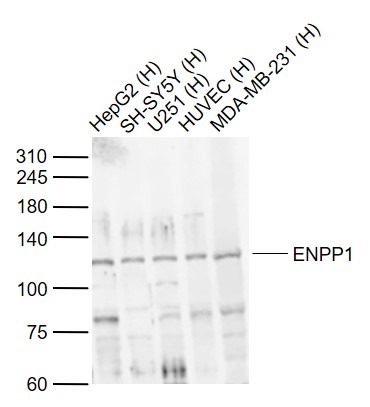Shopping Cart
Remove All Your shopping cart is currently empty
Your shopping cart is currently empty
Anti-ENPP1 Polyclonal Antibody is a Rabbit antibody targeting ENPP1. Anti-ENPP1 Polyclonal Antibody can be used in WB.
| Pack Size | Price | USA Warehouse | Global Warehouse | Quantity |
|---|---|---|---|---|
| 50 μL | $222 | 7-10 days | 7-10 days | |
| 100 μL | $372 | 7-10 days | 7-10 days | |
| 200 μL | $529 | 7-10 days | 7-10 days |
| Description | Anti-ENPP1 Polyclonal Antibody is a Rabbit antibody targeting ENPP1. Anti-ENPP1 Polyclonal Antibody can be used in WB. |
| Synonyms | PDNP1, PCA1ARHR2, PCA1, PC1, NPPS, NPPase, NPP1, M6S1NPP1, M6S1, Ly-41 Antigen, ENPP1, E-NPP 1 |
| Ig Type | IgG |
| Reactivity | Human (predicted:Mouse,Rat,Dog,Pig,Horse,Rabbit) |
| Verified Activity | Sample: Lane 1: Human HepG2 cell lysates Lane 2: Human SH-SY5Y cell lysates Lane 3: Human U251 cell lysates Lane 4: Human Huvec cell lysates Lane 5: Human MDA-MB-231 cell lysates Primary: Anti-ENPP1 (TMAB-00618) at 1/1000 dilution Secondary: IRDye800CW Goat Anti-Rabbit IgG at 1/20000 dilution Predicted band size: 100 kDa Observed band size: 120 kDa  |
| Application | |
| Recommended Dose | WB: 1:500-2000 |
| Antibody Type | Polyclonal |
| Host Species | Rabbit |
| Subcellular Localization | Cytoplasmic |
| Tissue Specificity | Expressed in plasma cells and also in a number of non-lymphoid tissues, including the distal convoluted tubule of the kidney, chondrocytes and epididymis. |
| Construction | Polyclonal Antibody |
| Purification | Protein A purified |
| Appearance | Liquid |
| Formulation | 0.01M TBS (pH7.4) with 1% BSA, 0.02% Proclin300 and 50% Glycerol. |
| Concentration | 1 mg/mL |
| Research Background | ENPP1 has a broad specificity and cleaves a variety of substrates, including phosphodiester bonds of nucleotides and nucleotide sugars and pyrophosphate bonds of nucleotides and nucleotide sugars. It can hydrolyze nucleoside 5' triphosphates such as ATP, GTP, CTP, TTP and UTP to their corresponding monophosphates with release of pyrophosphate. It can also hydrolyze diadenosine polyphosphates and 3',5'-cAMP to AMP. It may play a role in the regulation of pyrophosphate production, the regulation of the availability of nucleotide sugars in the endoplasmic reticulum and Golgi, and the regulation of purinergic signaling. The subtilisin-like Prohormone Convertase (PC) family is a group of cellular enzymes that cleave most prohormones and neuropeptide precursors. Numerous other cellular proteins, some viral proteins, and bacterial toxins that are transported by the constitutive secretory pathway are also targeted for maturation by PCs. PC family members share structural similarities, which include a heterogeneous ~10 kDa amino-terminal proregion, a highly conserved ~55 kDa subtilisin-like catalytic domain, and carboxyl-terminal domain that is heterogeneous in length and sequence. These enzymes become catalytically active following proregion cleavage within the appropriate cellular compartment. The subcellular localization of PC family members varies. Immunolocalization studies show that PC1 is found in the perinuclear region as well as the trans-Golgi network, whereas PC2 can be found in the trans-Golgi network as well as diffusely distributed in the peripheral cytoplasm. |
| Immunogen | KLH conjugated synthetic peptide: human ENPP1 |
| Antigen Species | Human |
| Gene Name | ENPP1 |
| Gene ID | |
| Protein Name | Ectonucleotide pyrophosphatase/phosphodiesterase family member 1 |
| Uniprot ID | |
| Biology Area | Diabetes,Bone |
| Function | Involved in the processing of hormone and other protein precursors at sites comprised of pairs of basic amino acid residues. Substrates include POMC, renin, enkephalin, dynorphin, somatostatin and insulin. |
| Molecular Weight | Theoretical: 100 kDa. |
| Stability & Storage | Store at -20°C or -80°C for 12 months. Avoid repeated freeze-thaw cycles. |
| Transport | Shipping with blue ice. |
| Size | Quantity | Unit Price | Amount | Operation |
|---|

Copyright © 2015-2026 TargetMol Chemicals Inc. All Rights Reserved.